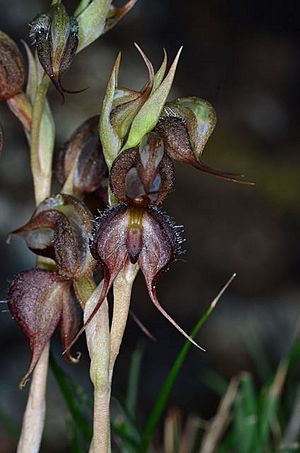Sikh's whiskers facts for kids
Quick facts for kids Sikh's whiskers |
|
|---|---|
 |
|
| Pterostylis boormanii growing in the Weddin Mountains National Park | |
| Scientific classification | |
| Genus: |
Pterostylis
|
| Species: |
boormanii
|
| Synonyms | |
|
Oligochaetochilus boormanii (Rupp) Szlach. |
|
The Pterostylis boormanii, often called the Sikh's whiskers, is a special kind of plant. It belongs to the amazing orchid family. This plant grows naturally only in south-eastern Australia. It has a group of leaves at its base that form a circle, like a rosette. Its flowers are a dark reddish-brown with parts that look like tiny see-through "windows." It also has a thick, brown, bristly part that looks a bit like an insect. This part is called the labellum.
What Does the Sikh's Whiskers Look Like?
The Sikh's whiskers orchid is a plant that grows from an underground tuber. A tuber is like a small, round storage root. This plant is a perennial, which means it lives for more than two years. It is also deciduous, so its leaves usually die back during certain times of the year.
At the bottom of its flowering stem, it has a group of leaves called a rosette. There are usually eight to fourteen oval-shaped leaves in this rosette. Each leaf is about 15 to 35 mm (0.6 to 1.4 in) long and 8 to 14 mm (0.3 to 0.6 in) wide. Often, these leaves have already withered away by the time the plant flowers.
The plant can have up to seven dark reddish-brown flowers. These flowers have parts that are see-through, like small windows. They are about 27 to 30 mm (1.1 to 1.2 in) long and 10 to 12 mm (0.4 to 0.5 in) wide. These flowers grow on a stem that can be 50 to 200 mm (2 to 8 in) tall. There are also two to five leaves wrapped around this flowering stem.
The top part of the flower, called the dorsal sepal, and the petals join together to form a hood. This hood is called a "galea." The dorsal sepal has a thin, thread-like tip that points upwards. This tip is about 8 to 10 mm (0.3 to 0.4 in) long. The side sepals, called the lateral sepals, point downwards. They are wider than the galea and have thick, hairy edges. They quickly narrow into thin tips that are 10 to 15 mm (0.4 to 0.6 in) long and spread apart.
The most interesting part is the labellum. It is thick, brown, and looks like an insect! It is about 4 to 5 mm (0.16 to 0.20 in) long and about 2 mm (0.08 in) wide. The "head" end of the labellum has many short hairs. The "body" part has five to eight hairs on each side, which can be up to 4 mm (0.16 in) long. This orchid usually flowers from September to November.
How It Got Its Name
The Pterostylis boormanii was first officially described in 1944. A botanist named Herman Rupp wrote about it in his book, Orchids of New South Wales. He described it from a plant found near Peak Hill.
The second part of its name, boormanii, is a special name called a specific epithet. It was chosen to honor John Boorman. He was the person who collected the very first plant specimen used to describe this species. This first plant is known as the type specimen.
Where Does It Grow?
The Sikh's whiskers orchid likes to grow in drier forests and scrubland. You can often find it in rocky areas. It also likes to grow near Callitris trees.
This orchid is found in New South Wales, starting from Narrabri and going south. It also grows across inland Victoria and in the south-east part of South Australia. It prefers areas that get an average of 250 to 500 mm (10 to 20 in) of rain each year.

